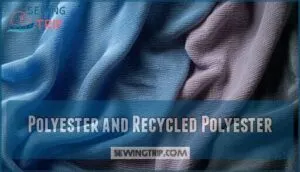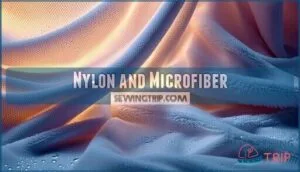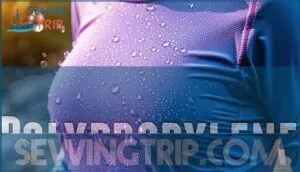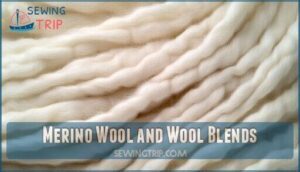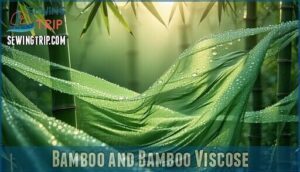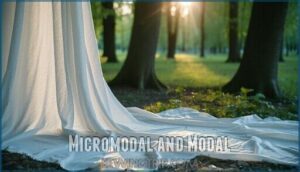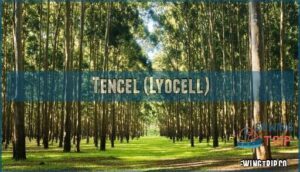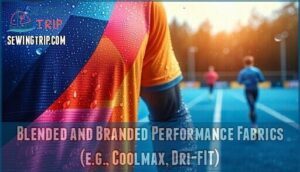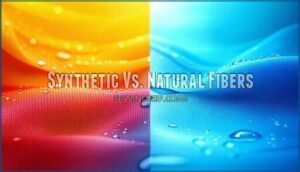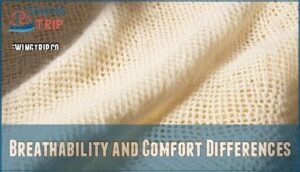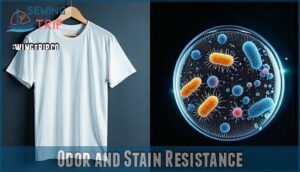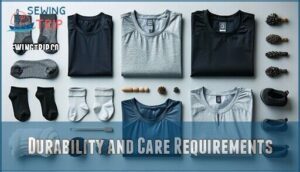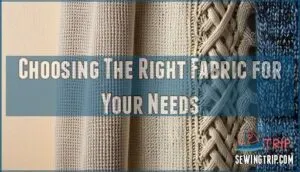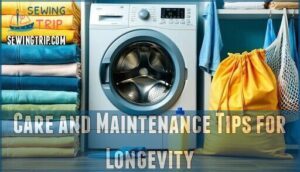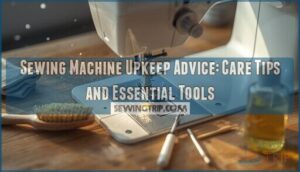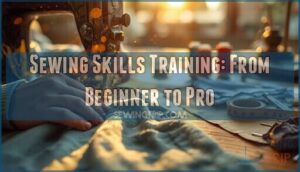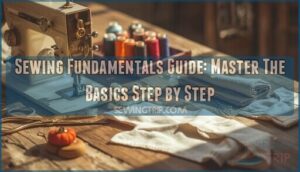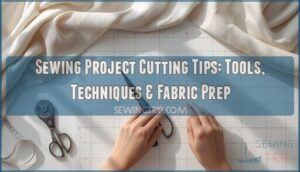This site is supported by our readers. We may earn a commission, at no cost to you, if you purchase through links.
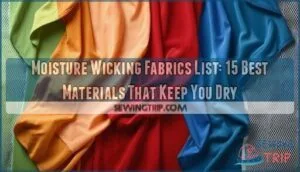
From budget-friendly polyester blends to premium Tencel innovations, each fabric brings unique moisture-transport technologies that keep you comfortable whether you’re crushing a marathon or simply traversing a sweltering summer commute.
Table Of Contents
Key Takeaways
- Synthetic fabrics like polyester and nylon deliver the fastest moisture-wicking performance with drying rates up to 13 mL/h, making them ideal for high-intensity workouts, though they retain more odor than natural alternatives.
- Natural fibers including merino wool and bamboo offer superior odor resistance and skin comfort with 27% fewer irritation reports, while providing excellent temperature regulation across varying climate conditions.
- Performance varies significantly by fabric type and intended use – lightweight synthetics excel for intense exercise, while natural blends work better for daily wear and sensitive skin applications.
- Proper care extends fabric lifespan to 50-200 wash cycles by using cold water, mild detergent, avoiding fabric softener, and air-drying to maintain moisture-wicking properties and prevent fiber degradation.
What Are Moisture-Wicking Fabrics?
Think of moisture-wicking fabrics as your personal cooling system – they grab sweat from your skin and move it to the outside where air can dry it fast.
What makes them work? The fabrics pull moisture through tiny channels in the fibers, then spread it across the surface so it evaporates quickly. This keeps you dry and comfortable whether you’re working out or just going about your day.
Key Properties and Technology
Today’s moisture-wicking fabrics work through clever engineering – tiny microchannels in the fibers pull sweat away from your skin using capillary action.
The smart design combines water-repelling outer layers that help moisture evaporate quickly with inner surfaces that actually grab and absorb sweat.
These fabrics are often constructed with a composite double-layer for peak performance. Refined thermoregulation tech and durability performance guarantee breathability through rigorous testing protocols that measure moisture management effectiveness.
How Moisture-Wicking Works
Think of moisture-wicking fabric as your body’s personal cooling system—it doesn’t just sit there like a sponge, but actively pulls sweat away from your skin through a process called capillary action. The fabric structure creates tiny channels that transport moisture from fiber to fiber, moving it toward the outer surface where faster evaporation rates keep you dry.
This moisture management happens in four steps:
- Capillary Action Draws Sweat – Fiber properties create microscopic pathways that pull moisture away from your skin
- Moisture Transport Through Layers – The fabric structure moves sweat from inner to outer surfaces via wicking ability
- Surface Evaporation – Once moisture reaches the fabric’s exterior, increased air exposure accelerates drying
- Continuous Cycle – This sweat transport process repeats, maintaining your body’s thermal regulation
Benefits for Active and Everyday Wear
Picture your favorite cotton t-shirt after an intense workout—it’s basically become a soggy, clingy second skin that takes forever to dry and leaves you feeling like you’ve been dunked in a lake. Moisture-wicking fabrics flip this script entirely.
These performance-driven materials excel at sweat management, pulling moisture away from your skin for rapid evaporation. The result? Enhanced comfort levels during athletic activities and improved breathability that prevents that sticky, uncomfortable feeling.
Whether you’re going through a busy day or just hitting the gym, moisture-wicking active wear delivers exceptional odor control and adaptable usage across different situations.
Comprehensive List of Moisture-Wicking Fabrics
When you’re shopping for activewear, you’ll run into tons of different moisture-wicking materials. Each one has its own strengths for keeping sweat off your skin.
You’ve got high-performance synthetics like polyester and nylon on one side, plus natural options like merino wool and bamboo on the other. The trick is finding what works best for how you move and what feels right against your skin.
Polyester and Recycled Polyester
Let’s explore Polyester and Recycled Polyester in a way that feels clear and practical. Polyester stands as the workhorse of synthetic fabrics, offering outstanding polyester durability and reliable moisture management.
You’ll find it in countless moisture-wicking fabrics because it pulls sweat away efficiently. Recycled polyester delivers the same performance impact while reducing environmental footprint—recycled benefits without compromising function.
However, microfiber concerns include potential odor retention. Blending options with natural fibers create balanced performance for various activities.
Nylon and Microfiber
Nylon takes moisture-wicking to the next level with its amazing strength and lightning-fast drying time, while microfiber adds a silky-smooth touch that feels almost too good to be workout gear.
Nylon durability makes it perfect for performance blends in activewear that won’t quit after countless washes. The microfiber structure creates outstanding tactile comfort while pulling sweat away efficiently.
These synthetic fabrics excel in apparel applications where you need fabric properties that deliver both function and feel-good performance.
Polypropylene
Think of polypropylene as the marathon runner’s secret weapon—this lightweight synthetic fabric doesn’t just wick moisture, it practically repels it. With remarkable thermal regulation properties, polypropylene maintains comfort across temperature ranges while offering outstanding durability factors that make it ideal for intensive use.
- Hydrophobic nature: Polypropylene properties include natural water resistance, absorbing less than 0.1% moisture
- Odor retention concerns: Unlike natural fibers, this synthetic fabric can trap odors over time
- Market applications: Widely used in base layers, athletic wear, and outdoor gear for its reliable wicking ability
Merino Wool and Wool Blends
Who would’ve thought that sheep could outperform synthetic fabrics in terms of moisture management? Merino wool‘s natural fibers excel at temperature regulation through unique fabric properties that adapt to your body’s needs. This wool innovation maintains thermal balance across a 21°C differential, making it better for active wear.
Merino wool’s natural fibers outperform synthetics by maintaining thermal balance across a 21°C range, adapting seamlessly to your body’s changing needs
| Wool Grades | Blend Performance |
|---|---|
| Superfine (18.5 microns) | 100% merino for greatest comfort |
| Fine (19.5 microns) | 70/30 merino-synthetic blends |
| Medium (20.5 microns) | Budget-friendly wool blends |
Ethical concerns around wool sourcing drive innovation in sustainable farming practices, assuring both performance and responsibility.
Bamboo and Bamboo Viscose
Bamboo fabric might sound like something pandas would wear, but this surprisingly soft material has become a breakthrough in the moisture-wicking world. Through viscose processing, bamboo transforms into incredibly breathable natural fibers with impressive fabric properties.
You’ll find bamboo’s comfort rivals synthetic performance fabrics, while its sustainability credentials outshine traditional materials. Many fabric blends now incorporate bamboo viscose for enhanced moisture-wicking performance.
Micromodal and Modal
If you’ve ever slipped into pajamas that felt like silk against your skin but dried faster than you could say "moisture-wicking," you’ve likely experienced the magic of micromodal and modal fabrics.
These natural fibers come from beech trees through sustainable modal production processes. Micromodal benefits include remarkable fabric softness that rivals luxury materials, while blended fabrics combine these properties with enhanced durability.
Their unique fabric properties make them perfect moisture-wicking fabrics for intimate apparel and sleepwear.
Tencel (Lyocell)
Made from eucalyptus trees, Tencel (Lyocell) transforms one of nature’s fastest-growing resources into a fabric that feels like silk but performs like a high-tech moisture-wicking material.
This natural fiber excels at moisture absorption while maintaining breathability that rivals synthetic alternatives.
Tencel’s sustainability credentials make it a standout choice among moisture-wicking fabrics, offering biodegradable performance without compromising comfort or durability.
Blended and Branded Performance Fabrics (e.g., Coolmax, Dri-FIT)
The powerhouses of moisture-wicking technology aren’t just single fibers—they’re engineered branded blend performance fabrics that set the highest standard. Coolmax fabric achieved the highest wicking efficiency tests at 102mm in 10 minutes, while DriFIT uses sophisticated material technology for exceptional performance fabrics.
What makes these performance fabrics so effective in athletic wear comes down to three key breakthroughs:
- Lightning-fast drying cycle times – Coolmax completes full drying in 45-60 minutes under controlled conditions
- Precision-engineered fibers – Multi-channel polyester increases capillary surface area by four times compared to traditional structures
- Sport-specific moisture control – Digital computational design creates targeted wicking zones based on sweat data
This moisture-wicking technology represents the cutting edge of athletic performance, combining decades of textile engineering into fabrics that work harder than your toughest workout. Nike’s Dri-FIT technology uses a unique microfiber construction to boost moisture management.
Comparing Moisture-Wicking Fabric Types
Here’s the thing about moisture-wicking fabrics—they’re not all created equal, and picking the wrong one can leave you feeling like a sweaty mess.
While synthetic materials like polyester excel at moving moisture quickly, natural fibers like merino wool offer enhanced odor resistance and temperature regulation.
Synthetic Vs. Natural Fibers
The battle between synthetic fabrics and natural fibers reveals distinct performance profiles. Synthetic options like polyester achieve drying rates up to 13 mL/h, dramatically outpacing natural fibers’ typical 5 mL/h. However, polyester retains three times more odor than wool or cotton.
Natural fibers offer enhanced skin compatibility, with 27% fewer irritation reports compared to synthetics. While synthetic materials boast a longer fabric lifespan (3-5 years versus 2-4), natural options minimize environmental impact through biodegradability.
Breathability and Comfort Differences
Think of breathability as your fabric’s ability to let your skin breathe—some materials act like a second skin while others feel more like wearing a plastic bag.
Natural fibers like merino wool excel at fabric airflow and thermal properties, preventing skin irritation through enhanced tactile feel.
Synthetic options vary dramatically in comfort levels, with tightly woven polyester restricting airflow while open-weave nylon enhances layering effects and overall skin comfort.
Odor and Stain Resistance
Naturally, odor and stain resistance varies dramatically between moisture-wicking fabrics. Synthetic fibers like polyester create perfect breeding grounds for odor-causing bacteria, leading to persistent body odor even after washing. That’s why antimicrobial treatments become essential for synthetic performance wear.
- Polyester: Fosters highest bacterial populations, requiring antimicrobial properties for odor control
- Merino wool: Naturally resists odor-causing bacteria with 2-4 times less body odor than synthetics
- Silver treatments: Achieve 99.99% bacterial reduction, maintaining effectiveness through 75 wash cycles
- Stain removal: Hydrophilic fabrics show 75% removal rates, while oil-resistant coatings prevent yellow stains
Durability and Care Requirements
Your investment in moisture-wicking gear won’t pay off if you don’t know how to take care of it properly.
Synthetic fabrics like polyester last longer but need gentle washing techniques with mild detergent to prevent damage.
Natural fibers require more careful drying methods and specific garment care to maintain their moisture-wicking properties and fabric lifespan effectively.
Choosing The Right Fabric for Your Needs
Picking the right moisture-wicking fabric comes down to three things: what you’re doing, where you’re doing it, and how your skin handles different materials.
Consider your activity level, climate conditions, skin sensitivity, and environmental values when selecting from polyester’s durability, merino wool’s natural comfort, or bamboo’s eco-friendly properties.
Intended Use (Workout, Outdoor, Daily Wear)
Picking the right moisture-wicking fabric isn’t a one-size-fits-all decision—it’s like choosing the perfect tool for the job, where your intended activity determines which material will serve you best.
High-intensity workouts demand lightweight synthetic athletic apparel with enhanced moisture-wicking properties, while outdoor gear requires durable fabric weight for layering systems.
Daily active wear balances comfort levels with style preferences across various activity intensity levels.
Climate and Seasonal Considerations
Mother Nature doesn’t stick to a nine-to-five schedule, and neither should your fabric choices when the weather decides to throw you a curveball.
Your seasonal fabric choice strategy should match climate-specific activities—merino wool’s thermal properties excel in cold-weather gear, while breathable polyester manages summer’s heat.
Smart layering strategies let you adapt: moisture-wicking base layers for temperature regulation, weather protection shells when storms hit.
Sensitivity and Skin Health
If you’ve ever experienced irritation from scratchy workout clothes or developed a rash from synthetic fabrics, you know that not all moisture-wicking materials play nicely with sensitive skin.
Natural fibers like merino wool and bamboo offer enhanced skin breathability with fewer chemical sensitivities compared to synthetic options.
For dermatological impacts and allergy concerns, choose fabrics with minimal chemical treatments that promote hygiene without compromising skin comfort.
Eco-Friendly and Sustainable Options
Beyond performance, sustainable moisture-wicking fabrics offer compelling environmental benefits. Recycled polyester uses 59% less energy than virgin materials, while Tencel’s closed-loop production recycles 99% of water and solvents.
Natural fibers like organic cotton consume 91% less water during cultivation, and bamboo grows without pesticides.
Look for GOTS, OCS, or OEKO-TEX certifications when choosing eco-friendly options.
Care and Maintenance Tips for Longevity
Your moisture-wicking fabrics won’t keep performing at their best without proper care. The right washing, drying, and storage techniques can extend your gear’s lifespan while maintaining its sweat-fighting superpowers.
Washing and Drying Best Practices
Think of your moisture-wicking gear like a high-performance sports car—without proper maintenance, even the best technology will lose its edge and leave you stranded with soggy, uncomfortable fabric.
For proper garment care, use cold water and mild detergent when washing instructions call for gentle treatment. Skip hot water temperatures that damage fibers, and choose air drying methods over high heat for fabric care recommendations and effective odor control.
Avoiding Fabric Softener and Bleach
Fabric softener might seem like your moisture-wicking gear’s best friend, but it’s actually the villain in this story—coating fibers with waxy residue that blocks their ability to transport sweat away from your skin.
Bleach damage is equally destructive, breaking down synthetic fibers and destroying their performance capabilities.
Stick with mild detergent and alternative cleaners like white vinegar to prevent softener buildup and maintain your gear’s moisture-moving magic.
Storage and Odor Prevention
Your freshly washed moisture-wicking gear won’t stay fresh for long if you stuff it into a dark, humid closet where bacteria can throw their own little party.
Proper storage means hanging your breathable fabrics in well-ventilated areas where air can circulate freely. This simple step prevents mildew and keeps those antiodor fabrics working at their best for better hygiene.
Extending Performance and Lifespan
Like any high-performance gear, your moisture-wicking fabrics need the right care to deliver peak results season after season. Smart caring for moisture-wicking clothing preserves their fabric properties and extends their working life considerably.
- Use enzyme-based detergents that break down sweat proteins without harsh chemicals
- Air-dry garments away from direct sunlight to prevent fiber degradation
- Store clean, completely dry pieces in breathable garment bags
- Wash inside-out to protect surface treatments and maintain performance restoration
- Replace worn items when wicking ability diminishes despite proper maintenance
Frequently Asked Questions (FAQs)
Which moisture-wicking fabrics prevent chafing best?
Premium synthetic fabrics like merino wool excel at preventing fabric friction factors through smooth fiber construction and body mapping design that reduces seam placement impact on pressure points.
Do moisture-wicking fabrics work in humid climates?
Humidity’s impact on moisture-wicking fabrics reduces their effectiveness, but they still outperform cotton by maintaining breathability and temperature regulation.
Drying time increases considerably, though sweat-wicking fabric continues providing enhanced moisture management during high activity intensity.
Can moisture-wicking fabrics cause skin reactions?
Ironically, materials designed for comfort can sometimes trigger discomfort. Fabric allergens, dye sensitivities, and chemical residues in moisture-wicking fabrics may cause skin reactions, particularly with synthetic fabrics requiring enhanced odor control through aggressive treatments.
How long do moisture-wicking properties last?
Depending on fabric type and care practices, moisture-wicking properties usually last 50-200 wash cycles before performance indicators show noticeable fabric degradation and reduced wicking ability.
- Synthetic fabrics like polyester maintain moisture-wicking technology longer than natural fibers due to their inherent chemical structure
- Wash frequency and detergent impact directly affect how quickly fabric properties comparison shows declining performance
- Additive lifespan in treated fabrics degrades faster with harsh detergents, fabric softeners, and high-temperature washing
- Performance indicators include slower drying times, increased moisture retention, and reduced breathability during active wear
- Moisture-wicking fabrics with permanent fiber construction outlast those relying on temporary chemical treatments or surface coatings
Are moisture-wicking fabrics suitable for sleepwear?
Absolutely. Moisture-wicking fabrics excel in sleepwear applications, particularly for hot sleepers or those experiencing night sweats.
Bamboo and merino wool offer enhanced breathability and temperature regulation while remaining gentle against sensitive skin, unlike synthetic options that may trap odors.
Conclusion
Significant advances in fabric technology have completely transformed how we stay comfortable, making the right choice from this moisture-wicking fabrics list absolutely game-changing for your performance and daily comfort.
Whether you’re chasing personal records or simply managing humid commutes, selecting synthetic powerhouses like polyester or natural champions like merino wool determines your success.
Don’t let poor fabric choices sabotage your goals.
- https://www.rvca.com/blogs/expert-guides/choose-workout-moisture-wicking-fabrics
- https://www.acs.org/content/dam/acsorg/education/resources/highschool/chemmatters/documents/dont-sweat-it.pdf
- https://fabricandflow.com/blogs/news/what-is-the-best-fabric-for-wicking-moisture-our-top-5-choices
- https://www.researchandmarkets.com/reports/6089849/moisture-wicking-fabrics-market-report
- https://www.giiresearch.com/report/go1739356-moisture-wicking-fabrics.html

